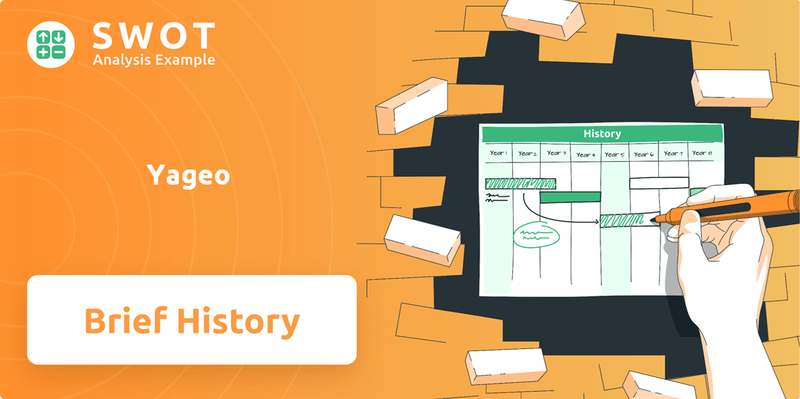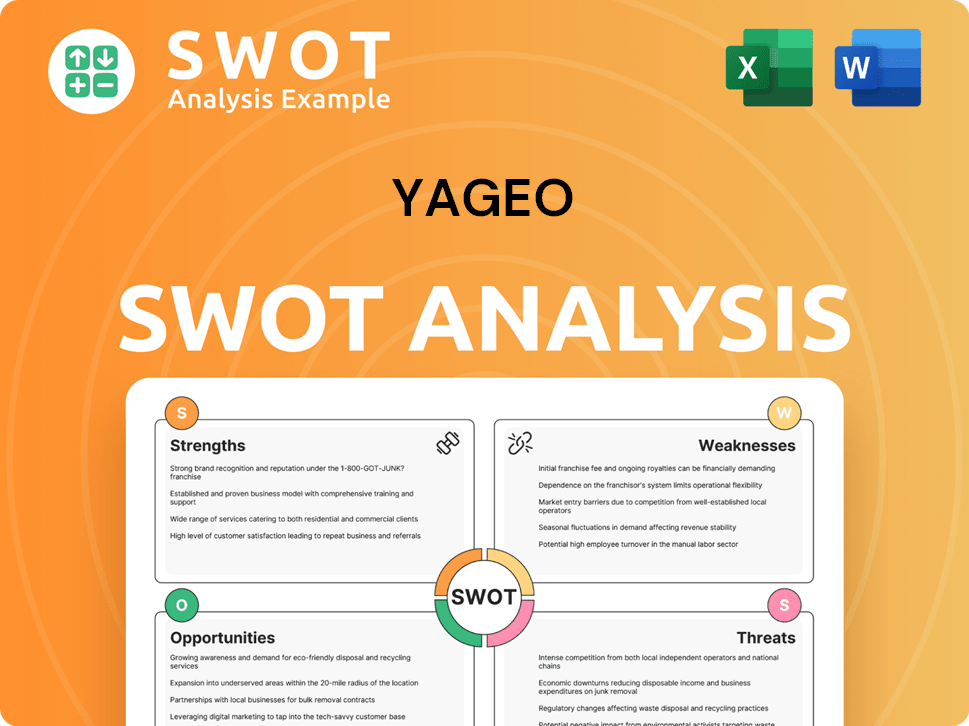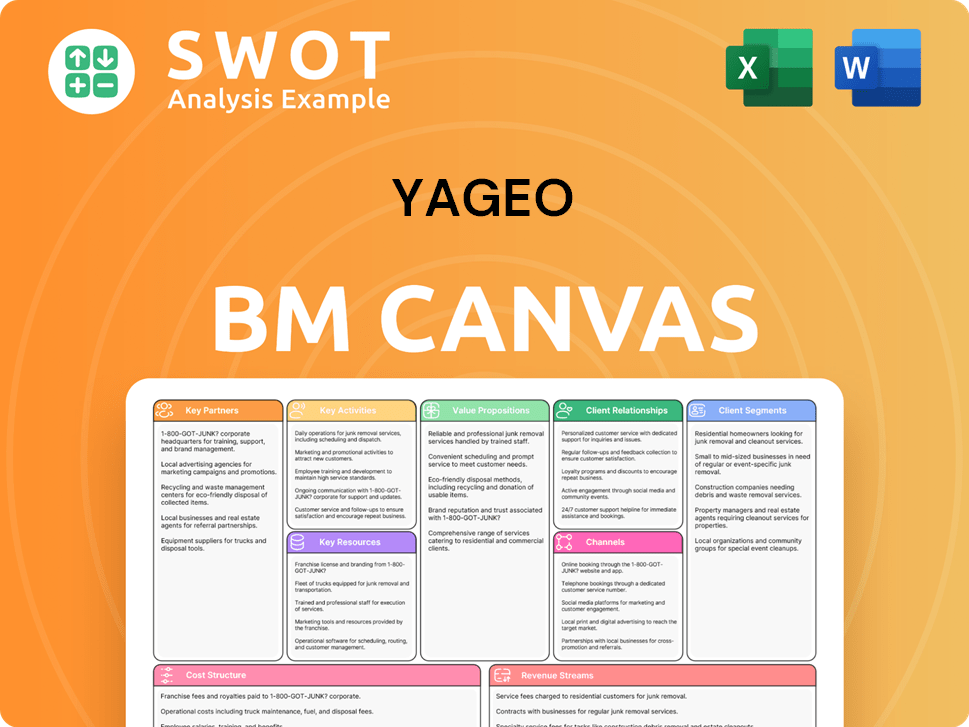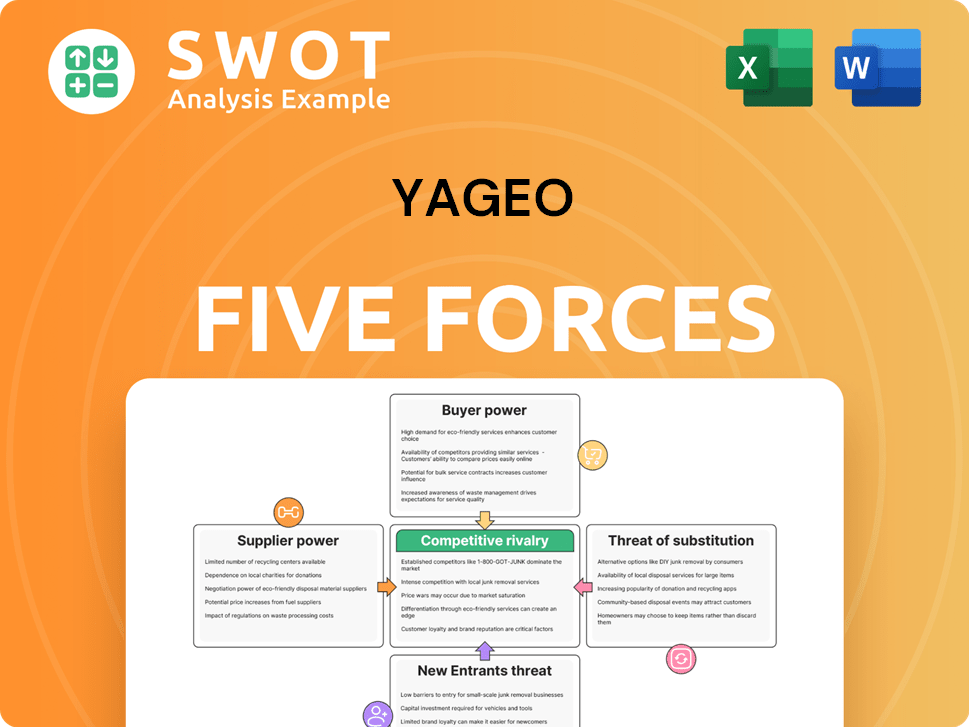Yageo Bundle
How did Yageo become a global leader in electronic components?
From its humble beginnings in Taiwan, Yageo Corporation has become a dominant force in the global electronics market. This Yageo SWOT Analysis reveals the strategic moves that propelled the company to the forefront. Discover the pivotal moments that transformed a regional supplier into a worldwide powerhouse, shaping the landscape of passive components.

The story of Yageo, a prominent Taiwanese manufacturer, is a compelling narrative of growth and strategic adaptation. Exploring the Yageo history reveals a company that has consistently evolved to meet the demands of an ever-changing technological landscape. Understanding the Yageo company background is crucial for investors and industry professionals alike, offering insights into its market share, key milestones, and the strategic acquisitions that have defined its trajectory in the electronic components sector.
What is the Yageo Founding Story?
The story of the Yageo company began in 1977. Founded by Pierre Chen in Taiwan, the company quickly became a significant player in the electronic components market.
Chen's vision was to supply essential parts for the growing electronics industry. This strategic move positioned Yageo to capitalize on the increasing demand for components in various products.
Yageo's early focus on surface-mount components marked a key technological shift. This focus allowed Yageo to establish itself as a key supplier in the rapidly expanding electronics market.
Pierre Chen founded the Yageo Corporation in 1977 in Taiwan, at the age of 21. He identified the growing need for electronic components.
- Chen, a graduate in engineering from National Cheng Kung University, leveraged his technical background.
- The company's initial focus was on automatic welding machines and carbon film resistors.
- Yageo aimed to become a global provider of passive components.
- The late 1970s in Taiwan provided a favorable environment for the growth of the electronics industry.
Yageo history began with a clear vision to supply the growing electronics market. The company's strategic focus on essential components, like resistors, capacitors, and inductors, has been key to its growth. Understanding the Yageo company background involves recognizing the early strategic decisions that shaped its trajectory.
Chen's background in engineering was critical. His education provided a strong foundation for entering the electronics industry. The company's early focus on surface-mount components highlights an understanding of the technological shifts. The cultural and economic context of Taiwan in the late 1970s played a role in the company's creation. The emergence of the electronics manufacturing sector provided a fertile ground for growth.
The Yageo company's early days were marked by a clear vision. The focus was on supplying components for products like mobile phones and automobiles. The company's initial involvement in automatic welding machines and carbon film resistors shows its early technological focus. For more insights into the competitive landscape, consider exploring the Competitors Landscape of Yageo.
Yageo SWOT Analysis
- Complete SWOT Breakdown
- Fully Customizable
- Editable in Excel & Word
- Professional Formatting
- Investor-Ready Format

What Drove the Early Growth of Yageo?
The early growth of the Yageo company involved expanding its offerings beyond initial carbon film resistors. A critical step in its development was the listing on the Taiwan Stock Exchange (TWSE: 2327.TW) in October 1993. This move provided capital for further expansion and acquisitions. This period saw the company strategically acquiring other businesses to broaden its product range and global presence.
In 1994,
These early efforts expanded the
Yageo PESTLE Analysis
- Covers All 6 PESTLE Categories
- No Research Needed – Save Hours of Work
- Built by Experts, Trusted by Consultants
- Instant Download, Ready to Use
- 100% Editable, Fully Customizable

What are the key Milestones in Yageo history?
The Yageo company's journey, a significant player in the electronic components industry, is marked by strategic milestones and expansions. From its beginnings, the Yageo has consistently adapted to market demands, growing its product portfolio and global reach through acquisitions and innovations. Understanding the Yageo history provides insights into its evolution and strategic positioning within the competitive landscape of the electronic components market.
| Year | Milestone |
|---|---|
| 1970 | Yageo was founded, marking the beginning of its journey as a Taiwanese manufacturer of passive components. |
| 2018 | Yageo acquired BrightKing and Pulse Electronics, expanding its product offerings and market presence. |
| 2020 | The merger with KEMET Corporation was completed, significantly broadening Yageo's product portfolio and client base, especially in the automotive sector. |
| 2022 | Yageo acquired Chilisin Electronics Corporation and Heraeus Nexensos GmbH, further diversifying its product range. |
| 2023 | Yageo completed the acquisition of Schneider Electric's Telemecanique Sensors, reinforcing its position in the sensor market. |
Yageo has consistently focused on innovation, particularly in miniaturization and high-reliability components. The company has developed specialized products for AI applications, contributing about 5% of its revenue from AI-related business. This focus includes high-capacity MLCCs used in AI servers.
Yageo focused on miniaturizing passive components for mobile and wearable devices, enabling smaller and more efficient electronics.
Development of high-reliability components for automotive and aerospace applications, ensuring performance in demanding environments.
Innovation in high-capacitance and high-voltage ceramic capacitors to meet the needs of power-intensive applications.
Focus on 5G-enabled RF components to support the growing demand for high-speed and reliable wireless communication.
Investment in sustainable materials and green manufacturing processes to reduce environmental impact.
Development of components and technologies to enhance power efficiency for AI applications, with AI-related business contributing about 5% to its revenue.
Despite its successes, Yageo has faced challenges, including market downturns and intense competition. To address these, Yageo has repositioned itself as a premium supplier, focusing on specialized products and long-term contracts. The company has also strategically entered the AI sector, developing components for AI applications.
Navigating economic slowdowns and fluctuations in demand for electronic components.
Facing strong competition from Chinese rivals, particularly in the standard components segment.
Focusing on specialized products and long-term contracts with key customers to maintain profitability.
Developing components for AI applications, contributing to about 5% of its revenue, to capitalize on the growing AI market.
Managing complex supply chains and ensuring the availability of raw materials and components.
Keeping pace with rapid technological advancements and the evolving needs of the electronics industry.
Yageo Business Model Canvas
- Complete 9-Block Business Model Canvas
- Effortlessly Communicate Your Business Strategy
- Investor-Ready BMC Format
- 100% Editable and Customizable
- Clear and Structured Layout

What is the Timeline of Key Events for Yageo?
The Yageo company has a rich history, starting in 1977 with its founding by Pierre Chen in Taiwan. The company quickly grew, becoming a publicly traded entity in 1993. Through strategic acquisitions and mergers, Yageo expanded its product offerings and global presence, solidifying its position as a leading Taiwanese manufacturer of electronic components. Key milestones include acquiring brands like Phycomp, Ferroxcube, and Pulse Electronics, as well as merging with KEMET in 2020. Recent acquisitions such as BrightKing, Heraeus Nexensos GmbH, and Telemecanique Sensors, along with the planned acquisition of Shibaura Electronics, highlight Yageo's commitment to growth and market diversification. The company's strategic moves, coupled with strong financial performance, underscore its resilience and forward-thinking approach in the competitive passive components market.
| Year | Key Event |
|---|---|
| 1977 | Yageo Corporation is founded in Taiwan. |
| 1993 (October) | Company stock is officially traded on the Taiwan Stock Exchange. |
| 1994 | Yageo acquires Singapore-based ASJ. |
| 1996 | Yageo acquires Vitrohm (Denmark) and Teapo (Taiwan). |
| 1997 | Yageo acquires Chilisin (Taiwan). |
| 2000 | Yageo acquires 'Phycomp' and 'Ferroxcube' brand names from Philips Electronics NV. |
| 2002 | Yageo acquires Stellar, Inc. |
| 2018 (September) | Yageo acquires BrightKing. |
| 2018 (December) | Yageo completes the acquisition of Pulse Electronics. |
| 2020 (June) | Yageo and KEMET complete their merger. |
| 2021 (May) | Yageo and Hon Hai Technology Group form a joint venture, XSemi Corporation. |
| 2022 (January) | YAGEO group acquires Chilisin Electronics Corporation, merging brands into Pulse Electronics. |
| 2022 (October) | Yageo agrees to acquire Heraeus Nexensos GmbH. |
| 2023 (November) | Yageo completes the acquisition of Telemecanique Sensors. |
| 2024 (March 31) | Yageo reports Q1 2024 net consolidated sales of NT$ 28.505 billion. |
| 2024 (December 31) | Yageo's full-year 2024 net consolidated sales reach NT$ 121.67 billion, with a net profit of NT$ 19.356 billion. |
| 2025 (February) | Yageo announces plans to acquire a 50.01% stake in Japan's Shibaura Electronics. |
| 2025 (April) | Yageo reports consolidated sales of NT$ 11.503 billion, setting a record for highest monthly revenue. |
Yageo aims to strengthen its position in the automotive and industrial markets. The company is focused on leading in 5G and IoT component supply, driving innovation in these key areas. By focusing on high-growth sectors, Yageo is positioning itself for sustained market leadership.
Expansion of manufacturing capabilities in low-cost regions is a priority for Yageo. The company is also developing next-generation high-frequency and high-reliability components. The acquisition of Shibaura Electronics further expands its sensor business and presence in the Japanese market.
Yageo is enhancing AI-driven manufacturing for improved efficiency. The company expects AI applications to drive growth in 2025. This focus on technology underscores Yageo's commitment to innovation and operational excellence.
Yageo plans to continuously improve profitability through strong market penetration, strict cost control, and in-depth segmentation strategies. The company's Q1 2024 net consolidated sales were NT$ 28.505 billion, up 9.2% year-on-year. Full-year 2024 net consolidated sales reached NT$ 121.67 billion, up 13.1% year-on-year, with a net profit of NT$ 19.356 billion.
Yageo Porter's Five Forces Analysis
- Covers All 5 Competitive Forces in Detail
- Structured for Consultants, Students, and Founders
- 100% Editable in Microsoft Word & Excel
- Instant Digital Download – Use Immediately
- Compatible with Mac & PC – Fully Unlocked

Related Blogs
- What is Competitive Landscape of Yageo Company?
- What is Growth Strategy and Future Prospects of Yageo Company?
- How Does Yageo Company Work?
- What is Sales and Marketing Strategy of Yageo Company?
- What is Brief History of Yageo Company?
- Who Owns Yageo Company?
- What is Customer Demographics and Target Market of Yageo Company?
Disclaimer
All information, articles, and product details provided on this website are for general informational and educational purposes only. We do not claim any ownership over, nor do we intend to infringe upon, any trademarks, copyrights, logos, brand names, or other intellectual property mentioned or depicted on this site. Such intellectual property remains the property of its respective owners, and any references here are made solely for identification or informational purposes, without implying any affiliation, endorsement, or partnership.
We make no representations or warranties, express or implied, regarding the accuracy, completeness, or suitability of any content or products presented. Nothing on this website should be construed as legal, tax, investment, financial, medical, or other professional advice. In addition, no part of this site—including articles or product references—constitutes a solicitation, recommendation, endorsement, advertisement, or offer to buy or sell any securities, franchises, or other financial instruments, particularly in jurisdictions where such activity would be unlawful.
All content is of a general nature and may not address the specific circumstances of any individual or entity. It is not a substitute for professional advice or services. Any actions you take based on the information provided here are strictly at your own risk. You accept full responsibility for any decisions or outcomes arising from your use of this website and agree to release us from any liability in connection with your use of, or reliance upon, the content or products found herein.